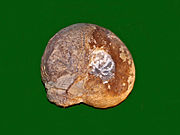
Goniatids, informally goniatites, are ammonoid cephalopods that form the order Goniatitida, derived from the more primitive Agoniatitida during the Middle Devonian some 390 million years ago. Goniatites (goniatitids) survived the Late Devonian extinction to flourish during the Carboniferous and Permian only to become extinct at the end of the Permian some 139 million years later.
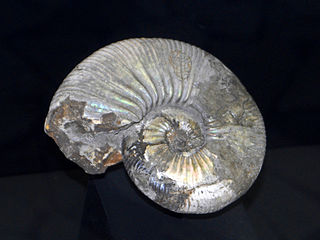
Acanthohoplites is an extinct genus of ammonites in the family Parahoplitidae that lived in the Aptian and Early Albian stages of the Early Cretaceous.

Audaxlytoceras is an extinct genus of lytoceratid ammonites.
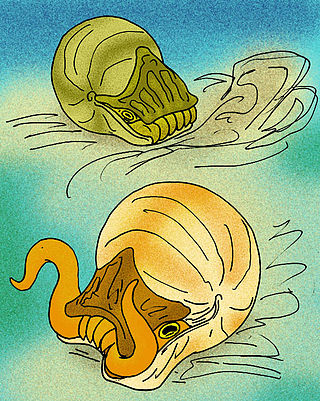
Arcestes is a genus of extinct ceratitid ammonites found in Triassic-aged marine strata.
Baschkirites is an extinct cephalopod genus belonging to the ammonoid order Goniatitida that lived during the Early Carboniferous (Bashkirian).
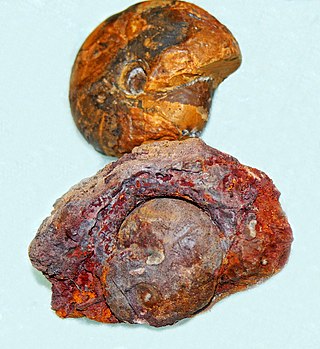
Beyrichoceras is a genus belonging to the goniatitid family Maxigoniatitidae that lived during the Mississippian Period

Clymenia is a genus in the ammonoid order Clymeniida, restricted to the Upper Devonian, characterized as with all clymeniids by a dorsal siphuncle that runs along the inside of the whorls, unusual for ammonoids.
Brevicoceras is an extinct nautiloid genus from the order Oncocerida with wide distribution in the Middle Devonian in Eastern North America, Russia and Morocco. Nautiloids form a broad group of shelled cephalopods that were once diverse and numerous but are now represented by only a handful of species in two genera.
Ankyloceras is a genus of Early Devonian cephalopods included in the oncocerid family Karoceratidae. The type species, Ankyloceras nesnayamiense named by Zhuravleva, 1974, comes from Nova Zemlya in Russia. Other species have been found in Japan, Morocco, and Russia.
Neocycloceras is an extinct genus of nautiloid included in the Pseudorthocerida that lived during the Late Devonian and Mississippian. Neoclycloceras is characterized by a slender, generally circular shell with slightly oblique, sinuous surficial annulations. Its sutures have dorsal and ventral saddles and lateral lobes and become more oblique with age. Saddles point forward, lobes to the rear. Dorsal saddles are broad and low but the ventral ones are high and conspicuous. The siphuncle is located between the center and venter and is nummuloidal, composed of rounded expanded segments, the inside of which contains a continuous laminar lining that is thickest in the middle of the segments and thinnest at the septal necks. Neocycloceras has been found in Pennsylvania in North America and in Morocco in north Africa.
Heminautilus is an extinct genus of nautiloids from the nautilacean family Cenoceratidae that lived during the Early Cretaceous. Fossils of Heminautilus have been registered in rocks of Barremian and Aptian age. Nautiloids are a subclass of shelled cephalopods that were once diverse and numerous but are now represented by only a handful of species.
Stearoceras is an extinct genus of prehistoric nautiloids from the Lower Pennsylvanian - Lower Permian with a fair worldwide distribution.(Kümmel 1964)
Gonionautilidae is a family in the nautilid superfamily Clydonautiliaceae that contains only the genus Gonionautilus, known from the Upper Triassic (Norian) of Europe and North America.

Gymnites is a genus of ammonoid cephalopod from the Middle Triassic belonging to the ceratitid family Gymnitidae. These nektonic carnivores lived during the Triassic period, the Anisian age.
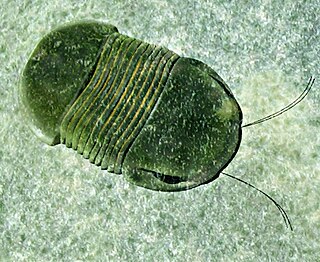
Bumastus is an extinct genus of corynexochid trilobites which existed from the Early Ordovician period to the Late Silurian period. They were relatively large trilobites, reaching a length of 6 in (15 cm). They were distinctive for their highly globular, smooth-surfaced exoskeleton. They possessed well-developed, large compound eyes and were believed to have dwelled in shallow-water sediments in life.
Bochianites is a straight shelled ammonite which lived from the Upper Jurassic, Tithonian, to the Lower Cretaceous, Hauterivian in what is now Europe, Greenland, Africa, North America and Asia. The shell is long, narrow, moderately expanding; smooth or with weak to strong oblique annular ribs. Sutural elements are short and boxy. The umbilical lobe, which lies between the lateral lobe and dorsal lobe, on either side, is about the same size as the lobule dividing the first lateral saddle.
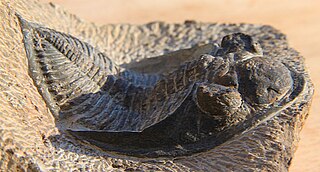
Odontochile is a genus of trilobites in the order Phacopida, family Dalmanitidae.

Panenka is a genus of fossil saltwater clams, marine bivalve molluscs in the family Praecardiidae. Like most bivalves, these molluscs were suspension feeders. They lived in the Devonian Period.

Monophyllites is an extinct cephalopod genus belonging to the family Ussuritidae that lived during the Triassic period, from Anisian to Ladinian age.
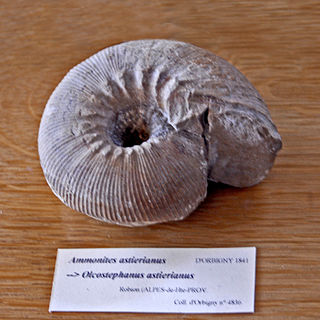
Olcostephanus is an extinct ammonoid cephalopod genus belonging to the family Olcostephanidae. These fast-moving nektonic carnivores lived during the Cretaceous, from the upper Valanginian to the lower Hauterivian age.


